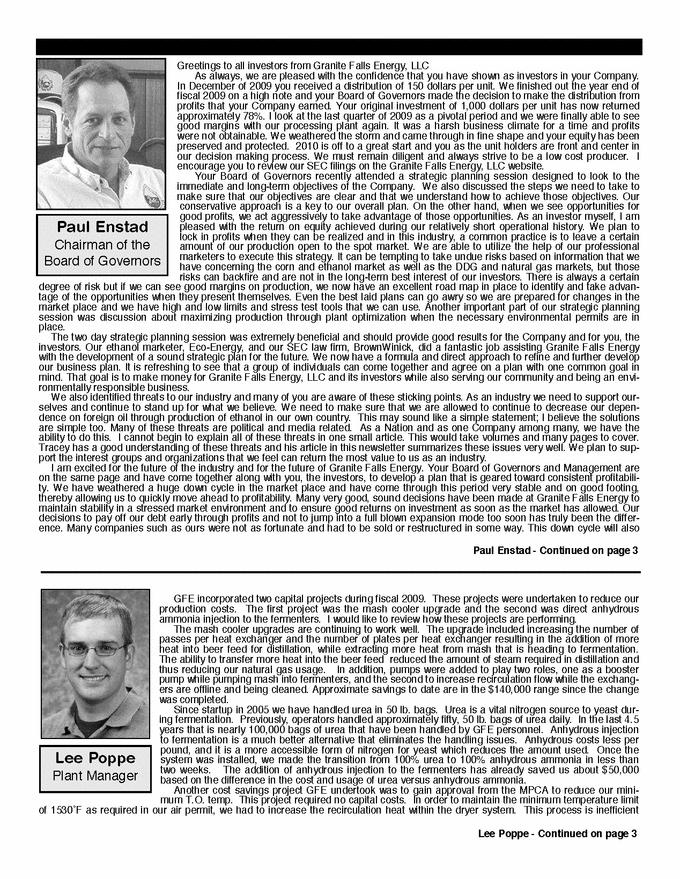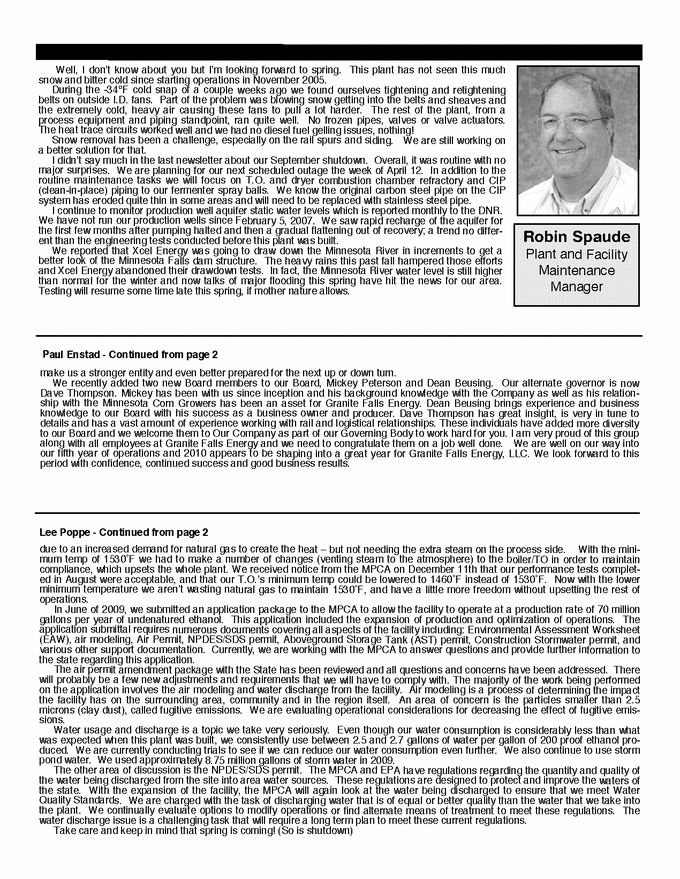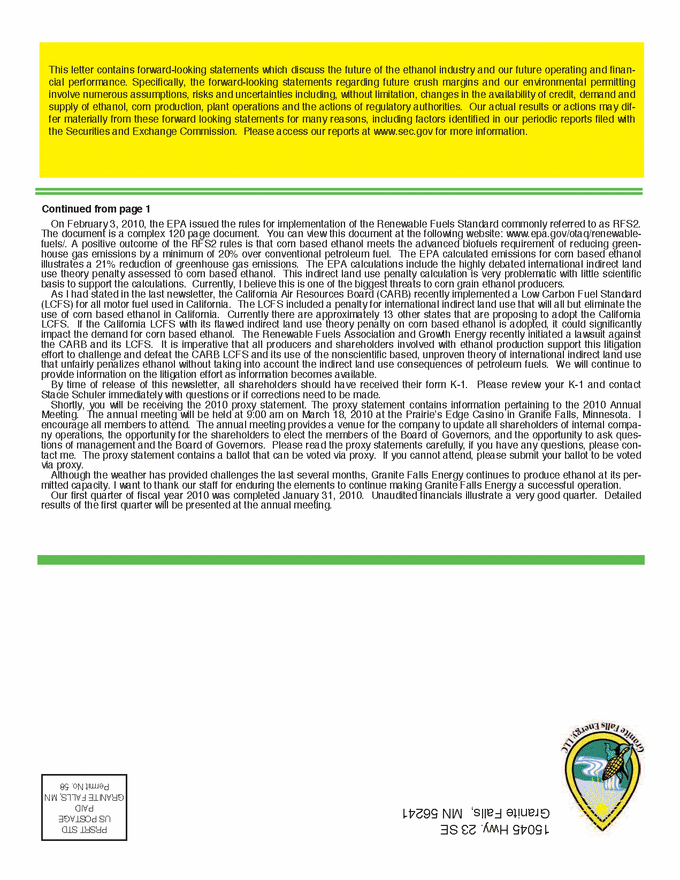Attached files
| file | filename |
|---|---|
| 8-K - 8-K - Granite Falls Energy, LLC | a10-4194_18k.htm |
Exhibit 99.1
|
|
Granite Falls Energy LLC. Producing Renewable Energy for a Cleaner Environment! From the desk of Tracey Olson Chief Executive Officer/General Manager February 2010 2009 was a tough year in the ethanol industry with many ethanol producers showing large losses, filing for bankruptcy protection and shutting down plants. Granite Falls Energy was not immune to the effects of the industry down turn. At the end of the second fiscal quarter, April 30, 2009, Granite Falls Energy reported a $2.6 million dollar deficit. The market started to turn around in May and Granite Falls Energy recovered from that $2.6 million dollar deficit to report a net income of approximately $1 million dollars at fiscal year end. The complete annual 10-K report can be found on the Granite Falls Energy’s website following the SEC link. I encourage you to read the annual report and contact Stacie Schuler or me with any questions. A key decision of our fiscal year 2009 was the termination of the Aventine ethanol marketing agreement and the commencement of an ethanol marketing agreement with Eco-Energy. The termination of the Aventine contract came at a cost, but the benefits of the new marketing agreement significantly outweighed the costs. The new agreement allows Granite Falls Energy to make the marketing decisions based upon our operational crush margins, not netback prices. The relationship with Eco-Energy continues to get stronger, and we are working with them on other risk management options that will continue to improve our profitability. The ethanol market continues to show good margins in the near term, but very small to negative margins in the deferred months. Unleaded gasoline demand is poor with demand being even less than it was a year ago. The bright side is that we are in the period for seasonal lows, and we typically start to see an increase of demand for motor fuels starting in late March. As a result of dramatically improved margins, the industry has seen most of the plants that were shutdown or slowed down being restarted and most if not all operating plants running at full capacity. The latest U.S. Energy Information Administration (EIA) report indicated that U.S. ethanol production reached an all time high of 761,000 barrels per day in November 2009, up from 668,000 barrels per day in November 2008. In addition, ethanol demand, as calculated by the Renewable Fuels Association, also reached an all time high of 781,000 barrels per day in November 2009 up from 683,000 barrels per day in November 2008. As a result of unleaded gasoline being priced higher than ethanol and the availability of the $0.45 blenders tax credit, there is an economic incentive to blend as much ethanol into unleaded fuel as possible. As long as that incentive to blend exists, I believe that you will continue to see good demand for ethanol, but there is a limit called the ‘blend wall’. The Renewable Fuels Standard mandates the use of 36 billion gallons of biofuels by the year 2022. To achieve the renewable fuel requirement in future years, ethanol will need to be blended into gasoline at levels greater than the current EPA limit of 10 percent, commonly called the ‘blend wall’. Growth Energy requested a waiver from the EPA in the spring of 2009 requesting the EPA to allow the use of up to a 15 percent ethanol blend in gasoline. The EPA responded to Growth Energy on November 30, 2009. In the EPA’s response, it stated that although not all of the studies are complete, engineering assessment to date indicates that the robust fuel, engine and emissions controls on newer vehicles (likely 2001 and newer model years) will likely be able to accommodate higher ethanol blends, such as E15. They go on to say that the DOE will continue to conduct tests on several vehicles used over many thousands of miles to evaluate the question of component durability and the long term emissions impacts of higher ethanol blends. The DOE studies are expected to be completed by August 2010. Presently, data is available on only two vehicles. However it is expected that testing will be completed on an additional 12 vehicles by the end of May. Should the test results remain supportive and provide the necessary basis, the EPA would be in a position to approve E15 for 2001 and newer vehicles in the mid-year time- frame. The EPA goes on to explain that a working group is being pulled together to examine and address labeling issues to allow final labeling requirements to be put in place soon after a waiver decision is made. It is the belief of many in the ethanol industry that a waiver for E15 will be granted for 2001 and newer vehicles this summer. This will allow for the potential for an increase in the demand for ethanol. We need to continue to monitor and push for the waiver to be approved. Continued on page 4 Check us out on the web at www.granitefallsenergy.com Phone 320-564-3100 |
|
|
|
|
|
Paul Enstad Chairman of the Board of Governors Greetings to all investors from Granite Falls Energy, LLC As always, we are pleased with the confidence that you have shown as investors in your Company. In December of 2009 you received a distribution of 150 dollars per unit. We finished out the year end of fiscal 2009 on a high note and your Board of Governors made the decision to make the distribution from profits that your Company earned. Your original investment of 1,000 dollars per unit has now returned approximately 78%. I look at the last quarter of 2009 as a pivotal period and we were finally able to see good margins with our processing plant again. It was a harsh business climate for a time and profits were not obtainable. We weathered the storm and came through in fine shape and your equity has been preserved and protected. 2010 is off to a great start and you as the unit holders are front and center in our decision making process. We must remain diligent and always strive to be a low cost producer. I encourage you to review our SEC filings on the Granite Falls Energy, LLC website. Your Board of Governors recently attended a strategic planning session designed to look to the immediate and long-term objectives of the Company. We also discussed the steps we need to take to make sure that our objectives are clear and that we understand how to achieve those objectives. Our conservative approach is a key to our overall plan. On the other hand, when we see opportunities for good profits, we act aggressively to take advantage of those opportunities. As an investor myself, I am pleased with the return on equity achieved during our relatively short operational history. We plan to lock in profits when they can be realized and in this industry, a common practice is to leave a certain amount of our production open to the spot market. We are able to utilize the help of our professional marketers to execute this strategy. It can be tempting to take undue risks based on information that we have concerning the corn and ethanol market as well as the DDG and natural gas markets, but those risks can backfire and are not in the long-term best interest of our investors. There is always a certain degree of risk but if we can see good margins on production, we now have an excellent road map in place to identify and take advantage of the opportunities when they present themselves. Even the best laid plans can go awry so we are prepared for changes in the market place and we have high and low limits and stress test tools that we can use. Another important part of our strategic planning session was discussion about maximizing production through plant optimization when the necessary environmental permits are in place. The two day strategic planning session was extremely beneficial and should provide good results for the Company and for you, the investors. Our ethanol marketer, Eco-Energy, and our SEC law firm, BrownWinick, did a fantastic job assisting Granite Falls Energy with the development of a sound strategic plan for the future. We now have a formula and direct approach to refine and further develop our business plan. It is refreshing to see that a group of individuals can come together and agree on a plan with one common goal in mind. That goal is to make money for Granite Falls Energy, LLC and its investors while also serving our community and being an environmentally responsible business. We also identified threats to our industry and many of you are aware of these sticking points. As an industry we need to support ourselves and continue to stand up for what we believe. We need to make sure that we are allowed to continue to decrease our dependence on foreign oil through production of ethanol in our own country. This may sound like a simple statement; I believe the solutions are simple too. Many of these threats are political and media related. As a Nation and as one Company among many, we have the ability to do this. I cannot begin to explain all of these threats in one small article. This would take volumes and many pages to cover. Tracey has a good understanding of these threats and his article in this newsletter summarizes these issues very well. We plan to support the interest groups and organizations that we feel can return the most value to us as an industry. I am excited for the future of the industry and for the future of Granite Falls Energy. Your Board of Governors and Management are on the same page and have come together along with you, the investors, to develop a plan that is geared toward consistent profitability. We have weathered a huge down cycle in the market place and have come through this period very stable and on good footing, thereby allowing us to quickly move ahead to profitability. Many very good, sound decisions have been made at Granite Falls Energy to maintain stability in a stressed market environment and to ensure good returns on investment as soon as the market has allowed. Our decisions to pay off our debt early through profits and not to jump into a full blown expansion mode too soon has truly been the difference. Many companies such as ours were not as fortunate and had to be sold or restructured in some way. This down cycle will also Paul Enstad - Continued on page 3 Lee Poppe Plant Manager GFE incorporated two capital projects during fiscal 2009. These projects were undertaken to reduce our production costs. The first project was the mash cooler upgrade and the second was direct anhydrous ammonia injection to the fermenters. I would like to review how these projects are performing. The mash cooler upgrades are continuing to work well. The upgrade included increasing the number of passes per heat exchanger and the number of plates per heat exchanger resulting in the addition of more heat into beer feed for distillation, while extracting more heat from mash that is heading to fermentation. The ability to transfer more heat into the beer feed reduced the amount of steam required in distillation and thus reducing our natural gas usage. In addition, pumps were added to play two roles, one as a booster pump while pumping mash into fermenters, and the second to increase recirculation flow while the exchangers are offline and being cleaned. Approximate savings to date are in the $140,000 range since the change was completed. Since startup in 2005 we have handled urea in 50 lb. bags. Urea is a vital nitrogen source to yeast during fermentation. Previously, operators handled approximately fifty, 50 lb. bags of urea daily. In the last 4.5 years that is nearly 100,000 bags of urea that have been handled by GFE personnel. Anhydrous injection to fermentation is a much better alternative that eliminates the handling issues. Anhydrous costs less per pound, and it is a more accessible form of nitrogen for yeast which reduces the amount used. Once the system was installed, we made the transition from 100% urea to 100% anhydrous ammonia in less than two weeks. The addition of anhydrous injection to the fermenters has already saved us about $50,000 based on the difference in the cost and usage of urea versus anhydrous ammonia. Another cost savings project GFE undertook was to gain approval from the MPCA to reduce our minimum T.O. temp. This project required no capital costs. In order to maintain the minimum temperature limit of 1530°F as required in our air permit, we had to increase the recirculation heat within the dryer system. This process is inefficient Lee Poppe - Continued on page 3 |
|
|
Well, I don’t know about you but I’m looking forward to spring. This plant has not seen this much snow and bitter cold since starting operations in November 2005. During the -34°F cold snap of a couple weeks ago we found ourselves tightening and retightening belts on outside I.D. fans. Part of the problem was blowing snow getting into the belts and sheaves and the extremely cold, heavy air causing these fans to pull a lot harder. The rest of the plant, from a process equipment and piping standpoint, ran quite well. No frozen pipes, valves or valve actuators. The heat trace circuits worked well and we had no diesel fuel gelling issues, nothing! Snow removal has been a challenge, especially on the rail spurs and siding. We are still working on a better solution for that. I didn’t say much in the last newsletter about our September shutdown. Overall, it was routine with no major surprises. We are planning for our next scheduled outage the week of April 12. In addition to the routine maintenance tasks we will focus on T.O. and dryer combustion chamber refractory and CIP (clean-in-place) piping to our fermenter spray balls. We know the original carbon steel pipe on the CIP system has eroded quite thin in some areas and will need to be replaced with stainless steel pipe. I continue to monitor production well aquifer static water levels which is reported monthly to the DNR. We have not run our production wells since February 5, 2007. We saw rapid recharge of the aquifer for the first few months after pumping halted and then a gradual flattening out of recovery; a trend no different than the engineering tests conducted before this plant was built. We reported that Xcel Energy was going to draw down the Minnesota River in increments to get a better look of the Minnesota Falls dam structure. The heavy rains this past fall hampered those efforts and Xcel Energy abandoned their drawdown tests. In fact, the Minnesota River water level is still higher than normal for the winter and now talks of major flooding this spring have hit the news for our area. Testing will resume some time late this spring, if mother nature allows. Robin Spaude Plant and Facility Maintenance Manager Paul Enstad - Continued from page 2 make us a stronger entity and even better prepared for the next up or down turn. We recently added two new Board members to our Board, Mickey Peterson and Dean Beusing. Our alternate governor is now Dave Thompson. Mickey has been with us since inception and his background knowledge with the Company as well as his relationship with the Minnesota Corn Growers has been an asset for Granite Falls Energy. Dean Beusing brings experience and business knowledge to our Board with his success as a business owner and producer. Dave Thompson has great insight, is very in tune to details and has a vast amount of experience working with rail and logistical relationships. These individuals have added more diversity to our Board and we welcome them to Our Company as part of our Governing Body to work hard for you. I am very proud of this group along with all employees at Granite Falls Energy and we need to congratulate them on a job well done. We are well on our way into our fifth year of operations and 2010 appears to be shaping into a great year for Granite Falls Energy, LLC. We look forward to this period with confidence, continued success and good business results. Lee Poppe - Continued from page 2 due to an increased demand for natural gas to create the heat — but not needing the extra steam on the process side. With the minimum temp of 1530°F we had to make a number of changes (venting steam to the atmosphere) to the boiler/TO in order to maintain compliance, which upsets the whole plant. We received notice from the MPCA on December 11th that our performance tests completed in August were acceptable, and that our T.O.’s minimum temp could be lowered to 1460°F instead of 1530°F. Now with the lower minimum temperature we aren’t wasting natural gas to maintain 1530°F, and have a little more freedom without upsetting the rest of operations. In June of 2009, we submitted an application package to the MPCA to allow the facility to operate at a production rate of 70 million gallons per year of undenatured ethanol. This application included the expansion of production and optimization of operations. The application submittal requires numerous documents covering all aspects of the facility including: Environmental Assessment Worksheet (EAW), air modeling, Air Permit, NPDES/SDS permit, Aboveground Storage Tank (AST) permit, Construction Stormwater permit, and various other support documentation. Currently, we are working with the MPCA to answer questions and provide further information to the state regarding this application. The air permit amendment package with the State has been reviewed and all questions and concerns have been addressed. There will probably be a few new adjustments and requirements that we will have to comply with. The majority of the work being performed on the application involves the air modeling and water discharge from the facility. Air modeling is a process of determining the impact the facility has on the surrounding area, community and in the region itself. An area of concern is the particles smaller than 2.5 microns (clay dust), called fugitive emissions. We are evaluating operational considerations for decreasing the effect of fugitive emissions. Water usage and discharge is a topic we take very seriously. Even though our water consumption is considerably less than what was expected when this plant was built, we consistently use between 2.5 and 2.7 gallons of water per gallon of 200 proof ethanol produced. We are currently conducting trials to see if we can reduce our water consumption even further. We also continue to use storm pond water. We used approximately 8.75 million gallons of storm water in 2009. The other area of discussion is the NPDES/SDS permit. The MPCA and EPA have regulations regarding the quantity and quality of the water being discharged from the site into area water sources. These regulations are designed to protect and improve the waters of the state. With the expansion of the facility, the MPCA will again look at the water being discharged to ensure that we meet Water Quality Standards. We are charged with the task of discharging water that is of equal or better quality than the water that we take into the plant. We continually evaluate options to modify operations or find alternate means of treatment to meet these regulations. The water discharge issue is a challenging task that will require a long term plan to meet these current regulations. Take care and keep in mind that spring is coming! (So is shutdown) |
|
|
This letter contains forward-looking statements which discuss the future of the ethanol industry and our future operating and financial performance. Specifically, the forward-looking statements regarding future crush margins and our environmental permitting involve numerous assumptions, risks and uncertainties including, without limitation, changes in the availability of credit, demand and supply of ethanol, corn production, plant operations and the actions of regulatory authorities. Our actual results or actions may differ materially from these forward looking statements for many reasons, including factors identified in our periodic reports filed with the Securities and Exchange Commission. Please access our reports at www.sec.gov for more information. Continued from page 1 On February 3, 2010, the EPA issued the rules for implementation of the Renewable Fuels Standard commonly referred to as RFS2. The document is a complex 120 page document. You can view this document at the following website: www.epa.gov/otaq/renewablefuels/. A positive outcome of the RFS2 rules is that corn based ethanol meets the advanced biofuels requirement of reducing greenhouse gas emissions by a minimum of 20% over conventional petroleum fuel. The EPA calculated emissions for corn based ethanol illustrates a 21% reduction of greenhouse gas emissions. The EPA calculations include the highly debated international indirect land use theory penalty assessed to corn based ethanol. This indirect land use penalty calculation is very problematic with little scientific basis to support the calculations. Currently, I believe this is one of the biggest threats to corn grain ethanol producers. As I had stated in the last newsletter, the California Air Resources Board (CARB) recently implemented a Low Carbon Fuel Standard (LCFS) for all motor fuel used in California. The LCFS included a penalty for international indirect land use that will all but eliminate the use of corn based ethanol in California. Currently there are approximately 13 other states that are proposing to adopt the California LCFS. If the California LCFS with its flawed indirect land use theory penalty on corn based ethanol is adopted, it could significantly impact the demand for corn based ethanol. The Renewable Fuels Association and Growth Energy recently initiated a lawsuit against the CARB and its LCFS. It is imperative that all producers and shareholders involved with ethanol production support this litigation effort to challenge and defeat the CARB LCFS and its use of the nonscientific based, unproven theory of international indirect land use that unfairly penalizes ethanol without taking into account the indirect land use consequences of petroleum fuels. We will continue to provide information on the litigation effort as information becomes available. By time of release of this newsletter, all shareholders should have received their form K-1. Please review your K-1 and contact Stacie Schuler immediately with questions or if corrections need to be made. Shortly, you will be receiving the 2010 proxy statement. The proxy statement contains information pertaining to the 2010 Annual Meeting. The annual meeting will be held at 9:00 am on March 18, 2010 at the Prairie’s Edge Casino in Granite Falls, Minnesota. I encourage all members to attend. The annual meeting provides a venue for the company to update all shareholders of internal company operations, the opportunity for the shareholders to elect the members of the Board of Governors, and the opportunity to ask questions of management and the Board of Governors. Please read the proxy statements carefully, if you have any questions, please contact me. The proxy statement contains a ballot that can be voted via proxy. If you cannot attend, please submit your ballot to be voted via proxy. Although the weather has provided challenges the last several months, Granite Falls Energy continues to produce ethanol at its permitted capacity. I want to thank our staff for enduring the elements to continue making Granite Falls Energy a successful operation. Our first quarter of fiscal year 2010 was completed January 31, 2010. Unaudited financials illustrate a very good quarter. Detailed results of the first quarter will be presented at the annual meeting. 15045 Hwy. 23 SE Granite Falls, MN 56241 PRSRT STD US POSTAGE PAID GRANITE FALLS, MN Permit No. 58 |




